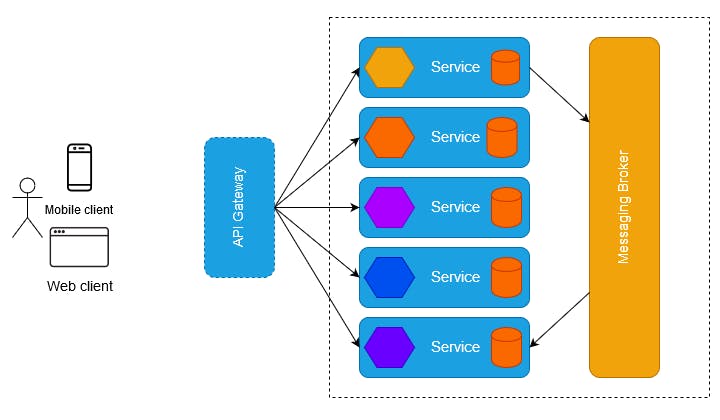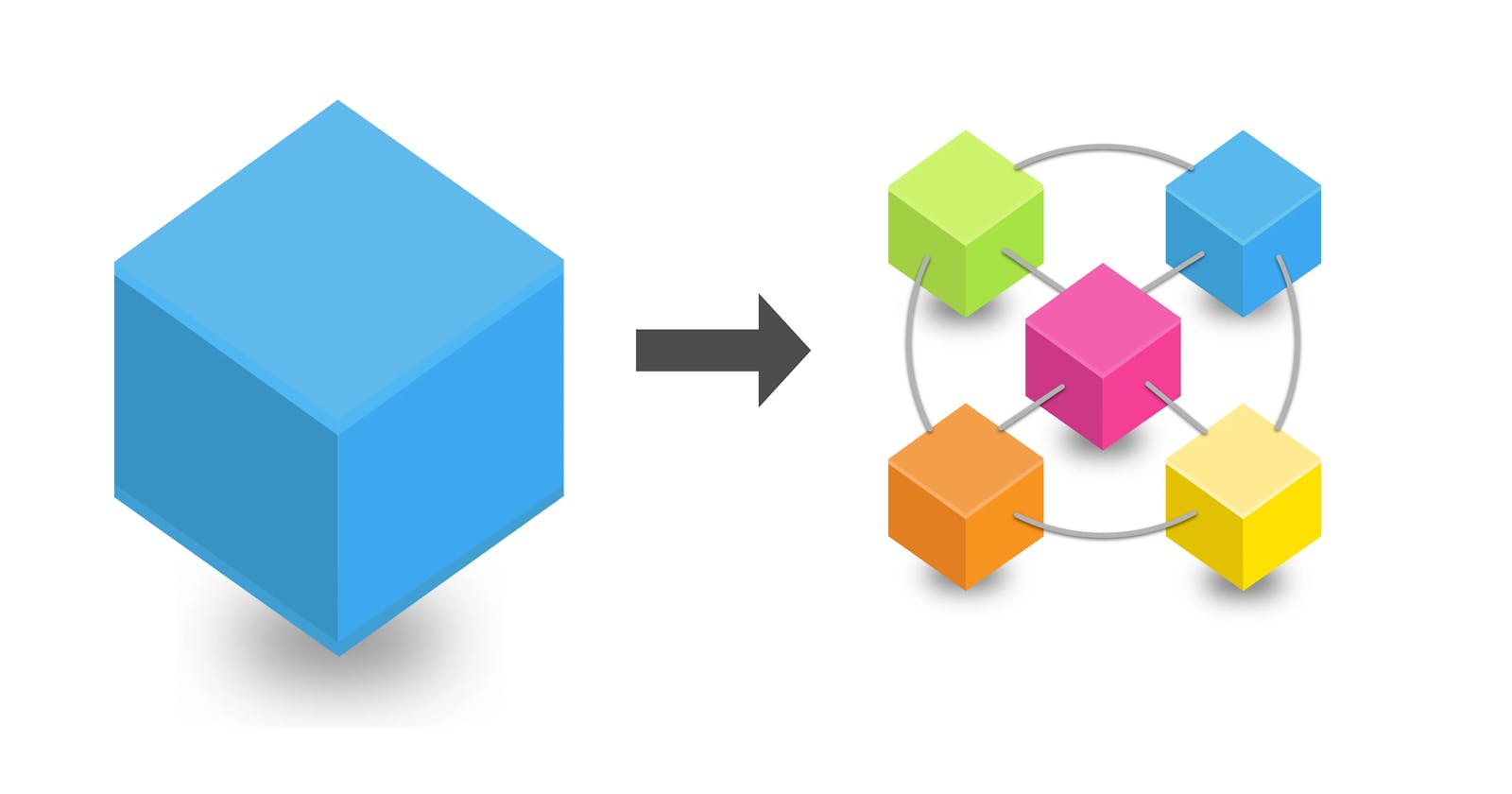Microservices is an architectural pattern that is becoming increasingly popular among software development teams. But before diving deep into Microservices Architecture it is important to know about Monolithic Architecture so let's first understand Monolithic Architecture.
Monolithic Architecture

What is Monolithic Architecture?
A monolithic architecture is a software design pattern in which all the components of an application are tightly integrated and built as a single, unified unit. In a monolithic architecture, the application is typically composed of a single, large codebase that contains all the functionality of the application. The application is then deployed as a single unit, usually as a single executable or a single web application.
For Example:
An example of a monolithic architecture would be a traditional three-tier web application. This type of application typically has three main components:
Front-end user interface:
Responsible for handling user interactions and displaying data to the user
Business logic layer:
Contains the core functionality of the application, such as processing user input, communicating with the data storage layer, and performing calculations
Data storage layer:
Responsible for storing and retrieving data from a database.
All these three components are tightly integrated and built as a single unit, and it's deployed as a single web application. The whole application communicates with one another via a common API, for example, the front-end requests the business layer and the business layer access the data storage layer to get the data and send it back to the front-end.
Challenges of Monolithic Architecture
Just like everything, Monolithic Architecture also has some cons. There are several challenges associated with a monolithic architecture:
Complexity:
As the application grows and becomes more complex, it can become difficult to manage and maintain. This is because all the components of the application are tightly integrated and built as a single unit, making it hard to understand how different parts of the application interact with one another.
Scalability:
A monolithic architecture can be difficult to scale. As the number of users and transactions increases, it can become more difficult to manage and maintain the application's performance. Additionally, it can be harder to scale and deploy different parts of the application independently.
Deployment:
A monolithic architecture requires the entire application to be deployed as a single unit, this can be time-consuming and can cause downtime. Also, deploying a new version of the application can be a complex process, as it requires all the components to be deployed together.
Testing:
Testing a monolithic architecture can be challenging, as it requires testing the entire application as a single unit, this can be time-consuming and complex.
Flexibility:
A monolithic architecture can be inflexible, as a change in one part of the application can have unintended consequences on other parts of the application, making it hard to make changes to the application without the risk of introducing bugs or breaking other parts of the application.
Reusability:
Reusing code can be difficult in a monolithic architecture, as all the code is tightly integrated and built as a single unit, and it can be hard to extract and reuse specific parts of the application.
In recent years, microservices architecture has become more popular as an alternative to monolithic architecture, it allows for breaking down a large application into smaller, independent, and loosely coupled services. This allows for more flexibility and scalability, but it also requires more complex deployment and management.
Microservices Architecture

What is Microservices Architecture?
Microservices is an architectural pattern that structures an application as a collection of small, independent services. Each service is responsible for a specific business capability and communicates with other services through a well-defined API. Each service runs in its own process and can be deployed and scaled independently.
The main idea behind microservices is to break down a large, monolithic application into smaller, more manageable services. This allows for more flexibility and scalability, as different services can be developed, deployed, and scaled independently. It also allows for more efficient management and maintenance of the application, as changes to one service have less impact on the rest of the application.
For Example:
A real-life example of a microservices architecture would be Netflix. Netflix has a large number of services that handle different aspects of the business, such as:
Video streaming:
Responsible for handling the delivery of video content to the user, it communicates with other services such as the user management service to check if the user is authorized to access the video, and with recommendation service to get the recommendations of other similar videos
User management:
Responsible for handling the management of user information, such as account creation, login, and subscription management, it communicates with other services such as the video streaming service and the recommendation service to get the necessary information to provide the best user experience.
Recommendation:
responsible for handling the management of product recommendations, such as personalized recommendations and it communicates with other services such as the video streaming service and the user management service to get the necessary information to provide the best recommendations
Each service is responsible for a specific business capability and communicates with other services through a well-defined API. This allows Netflix to scale and evolve its service offerings more efficiently, as well as to handle a large number of users and video streams. It also allows for more efficient use of resources, as each service can be optimized for its specific business capability, this allows for more efficient use of hardware, network, and other resources.
Benefits of Microservices Architecture
Scalability:
Microservices architecture allows for more flexibility and scalability, as different services can be developed, deployed, and scaled independently. This allows for better resource utilization and allows for the application to handle a larger number of users and transactions.
Resilience:
Microservices architecture allows for each service to be deployed on its own, this makes it possible to deploy a new version of a service without affecting the other services, and this increases the resilience of the system.
Flexibility:
Microservices architecture allows for greater flexibility in terms of technology choices, each service can be developed using the best suitable technology stack for its specific business capability, which allows for more efficient use of the available technologies.
Ease of Maintenance:
Microservices architecture allows for more efficient management and maintenance of the application, as changes to one service have less impact on the rest of the application. This makes it easier to update, fix bugs and troubleshoot the application.
Continuous Deployment:
Microservices architecture allows for more efficient deployment of new features and bug fixes, as each service can be deployed independently. This allows for faster time to market and continuous deployment of new features and bug fixes.
Reusability:
Microservices architecture allows for easier reuse of code, as services are independent and can be reused across different applications and projects.
Team autonomy:
Microservices architecture allows for more autonomy for the development teams, as each team is responsible for the development, deployment and maintenance of one service, this allows for better focus and faster development of new features.
How do Microservices communicate with each other?
There are several ways in which Microservices communicate with each other. Some of them are:
Microservices communicate with each other through a well-defined API, such as REST or gRPC. Both REST and gRPC are widely used in microservices architecture and both have their own advantages and disadvantages, it's important to choose the right one based on the specific requirements of the application.
Microservices can also communicate through message-oriented middleware such as Apache Kafka, RabbitMQ, or ActiveMQ. These messaging systems allow services to send and receive messages asynchronously, this allows for more decoupled and scalable communication between services.
Another way for microservices to communicate with each other is through an API gateway, an API gateway acts as a reverse proxy and provides a single entry point for external clients to access the services, it also provides functionalities such as authentication, authorization, rate-limiting, and caching.
Downsides of Microservices Architecture
While microservices architecture has many benefits, it also has some downsides:
Complexity:
Microservices architecture can introduce additional complexity, as there are now more moving parts and more services to manage and maintain. This can make it more difficult to understand how different services interact with one another and how data flows through the system.
Coordination:
Coordinating communication between multiple services can be challenging, as services are typically developed and deployed independently, and it can be difficult to ensure that all services are compatible and can work together.
Testing:
Testing a microservices architecture can be challenging, as it requires testing each service independently as well as testing the interactions between services.
Deployment:
Deploying a microservices architecture can be complex, as each service must be deployed and scaled independently.
Monitoring:
Monitoring a microservices architecture can be challenging, as it requires monitoring each service independently as well as monitoring the interactions between services.
Security:
Microservices architecture can introduce additional security risks, as there are now more services to secure and more communication channels to protect.
Data Management:
Data management can be challenging in a microservices architecture, as data is typically distributed across multiple services, and it can be difficult to maintain consistency and ensure data integrity.
Higher Resource Utilization:
Microservices architecture can increase resource utilization, as each service runs in its own process and each service may require its own set of resources such as CPU, Memory, and Disk.
What to choose: Microservices or Monolithic?

When considering the choice between microservices and monolithic architecture, it's important to consider the following factors:
The size and complexity of the application
The expected growth and scalability of the application
The availability and skill level of the development team
The need for faster time-to-market
The need for independent deployment and scaling of different features
The need for technology diversity
The need for better resource utilization
Monolithic architecture is best suited for small to medium-sized applications with a limited number of features, it's simple and easy to understand, it allows for centralized control over the entire application, and it is also easy to test and deploy. However, as the application grows and becomes more complex, it can become difficult to manage and maintain.
Microservices architecture is best suited for large, complex, and highly scalable applications, it allows for more flexibility and scalability, as different services can be developed, deployed, and scaled independently. It also allows for more efficient management and maintenance of the application, as changes to one service have less impact on the rest of the application. It also allows for more efficient use of resources, as each service can be optimized for its specific business capability.
Conclusion
In a nutshell, Microservices architecture is an architectural pattern that can help teams to develop and deploy applications more quickly and easily. It enables teams to work on smaller, more manageable code bases, use different technologies and programming languages, and scale applications more easily. However, managing the intercommunication between services can be challenging. With the right tools and processes in place, however, teams can successfully implement microservices and reap the benefits of this architectural pattern.
